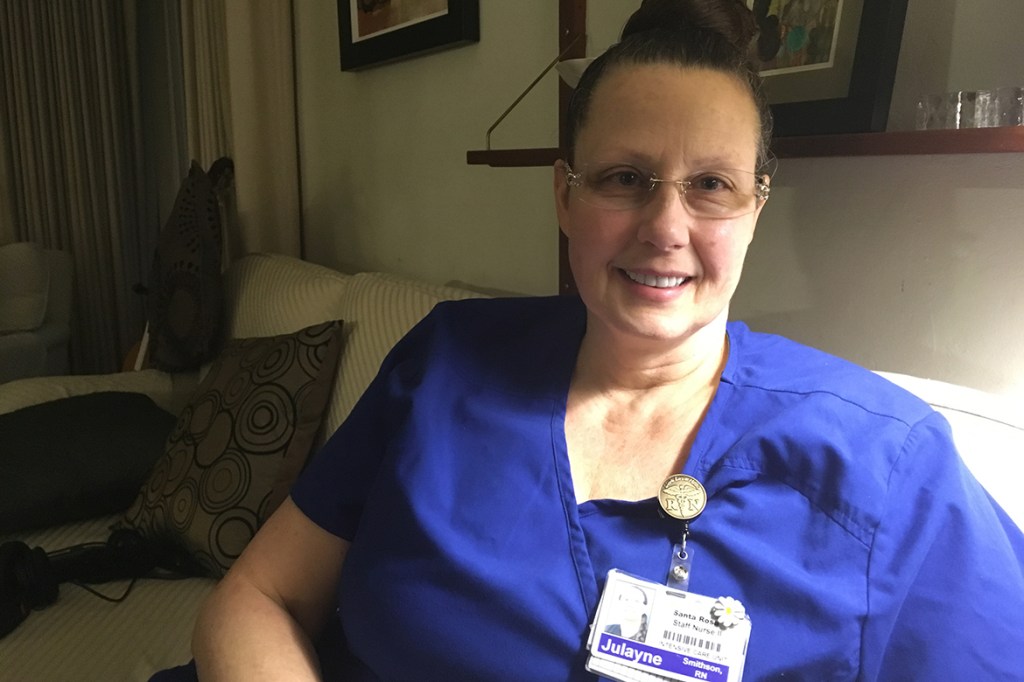Julayne Smithson was working an overnight shift in the Intensive Care Unit at the Kaiser Permanente hospital in Santa Rosa, Calif., when massive wildfires started racing through the city. Smithson had no idea how close they were. She was too busy taking care of her patient.
“One of the nurses came up to me and she said, ‘Julayne, I’m sorry, but your house is not going to make it,’” she said.
Smithson, 55, recently moved from Indiana and had just bought the house a few weeks ago. From the hospital window, she could see the flames moving through her neighborhood a block away.
“I was so busy working the last couple of weeks that I didn’t get my insurance, which I never do. I never ever, ever go uninsured,” she said. “I kept saying, ‘Tomorrow, I’m going to do that. Tomorrow, I’m going to do that.’”
Smithson asked a colleague to watch her patient and raced home to try to save a few things.
“I knew I didn’t have much time,” she said. “So I ran inside and I thought, ‘I have to get my nursing documents, because if I’m going to lose everything I own, I have to be able to work, to care for patients.’”
She grabbed the papers, a pair of scrubs and a nightgown, and raced back to the ICU. Over the next two hours, smoke filled the hospital.
“All of a sudden the police busted in the door and they said, ‘Everybody out,’” she said. “’Grab what you can carry, get your patients, and go now.’”
One of Kaiser’s emergency room doctors took charge as the fire approached, making the call to evacuate the hospital’s 130 patients. (Kaiser Permanente is not affiliated with Kaiser Health News.)
“It’s a really challenging decision to make, one you don’t make lightly,” said Joshua Weil, Kaiser’s ER doctor in charge that night. “You have to weigh the potential risk of moving hospitalized patients and patients from the emergency department, versus the risk of keeping them where they are.”
But the fire had moved suddenly toward the hospital. Firefighters told him the blaze was 100 to 200 yards away.
“They literally used the words, ‘We’re making the last stand,’” Weil said.
Staffers immediately started assessing and triaging patients.
Patients who could walk got on a bus provided by the city. Patients who couldn’t, like Smithson’s, had to wait for ambulances.
But Sutter Santa Rosa Regional Hospital was also evacuating its 80 or so patients, so ambulances were in high demand.
“A lot of nurses and staff were putting patients in their cars and driving them to the [other] hospital,” she said. “And then other people were carrying people on blankets, people who couldn’t walk, and putting them in cars.”
In the end, Smithson said they waited about 15 minutes for an ambulance — a very stressful 15 minutes. Her team was manually pumping air into her patient’s mouth with an air bag. A team of five had to push him, in his bed with all the monitors, through the parking lot several times to get away from fast-moving smoke and flames. His medication was running low and he was getting agitated.
“The pharmacy pre-mixes those medicines for us, but we didn’t have time to prepare extra medication for a trip like that because it just came up so fast,” she said.
Three hours passed from the moment the evacuation was called to the moment the last patient was out of the hospital, Weil said.
Smithson’s patient, and several others in critical condition, made it safely to Santa Rosa Memorial Hospital, about four miles away. About a hundred less critical patients were transferred to Kaiser’s hospital in San Rafael, about 40 miles away.
Beatrice Immoos was one of the nurses in San Rafael getting prepped to receive the influx.
“We were essentially told that we were in a disaster situation and all ratios were out the window,” she said, meaning nurses would be assigned more patients than usually allowed under California law. “They were going to start triaging people through the ER.”
She said patients were arriving wearing colored armbands, indicating the severity of their condition. “This level of disaster is a new one for us,” said Immoos. “It was very emotional, but there was a lot of resolve. The hospital put out calls for volunteer nurses to come help in San Rafael. Many responded, including Julayne Smithson. Her husband was supposed to fly in from Indiana in two days, but with their new home gone, she told him to wait.
“I said, ‘Well, I don’t have anywhere to go right now. And we don’t know what’s going on,’” she said. “So I said ‘I’ll go to San Rafael and help there.’”
Another nurse offered Smithson a pullout couch in a spare room. She’s been sleeping there during the day, and working 7 p.m. to 7 a.m. every night since the fire. She says all she wants to do right now is help patients, so she doesn’t have to think about what she’s lost.
This story is part of a partnership that includes KQED, NPR and Kaiser Health News.








